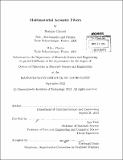Multimaterial acoustic fibers
Author(s)
Chocat, Noémie
DownloadFull printable version (17.84Mb)
Other Contributors
Massachusetts Institute of Technology. Department of Materials Science and Engineering.
Advisor
Yoel Fink.
Terms of use
Metadata
Show full item recordAbstract
The emergence of multimaterial fibers that combine a multiplicity of solid materials with disparate electrical, optical, and mechanical properties into a single fiber presents new opportunities for extending fiber applications well beyond optical transmission. Fiber reflectors, thermal detectors, photodetectors, chemical sensors, surface-emitting fiber lasers, fiber diodes, and other functional fiber devices have been demonstrated with this approach. Yet, throughout this development and indeed the development of fibers in general, a key premise has remained unchanged : that fibers are essentially static devices incapable of controllably changing their properties at high frequencies. Unique opportunities would arise if a rapid, electrically-driven mechanism for changing fiber properties existed. A wide spectrum of hitherto passive fiber devices could at once become active with applications spanning electronics, mechanics, acoustics, and optics, with the benefits of large surface-area, structural robustness, and mechanical flexibility. This thesis addresses the challenges and opportunities associated with the realization of electromechanical transduction in fibers through the integration of internal piezoelectric and electrostrictive domains. The fundamental challenges related to the fabrication of piezoelectric devices in fiber form are analyzed from a materials perspective, and candidate materials and geometries are selected that are compatible with the thermal drawing process. The first realization of a thermally drawn piezoelectric fiber device is reported and its piezoelectric response is established over a wide range of frequencies. The acoustic properties of piezoelectric fiber devices are characterized and related to their mechanical and geometric properties. Collective effects in multi-fiber constructs are discussed and demonstrated by the realization of a linear phased array of piezoelectric fibers capable of acoustic beam steering. High strain actuation capabilities in a fiber are demonstrated based on the integration of a highly electrostrictive relaxor ferroelectric polymer. The potential of this approach to realize integrated microelectromechanical systems in fibers is illustrated by the fabrication of a hybrid fiber comprising an electrostrictive device and an adjacent Fabry-Perot optical filter. Amplitude modulation of the light reflected from the Fabry-Perot cavity is demonstrated through electric field induced tuning of the cavity resonance.
Description
Thesis (Ph. D.)--Massachusetts Institute of Technology, Dept. of Materials Science and Engineering, 2012. Cataloged from PDF version of thesis. Includes bibliographical references (p. 141-150).
Date issued
2012Department
Massachusetts Institute of Technology. Department of Materials Science and EngineeringPublisher
Massachusetts Institute of Technology
Keywords
Materials Science and Engineering.